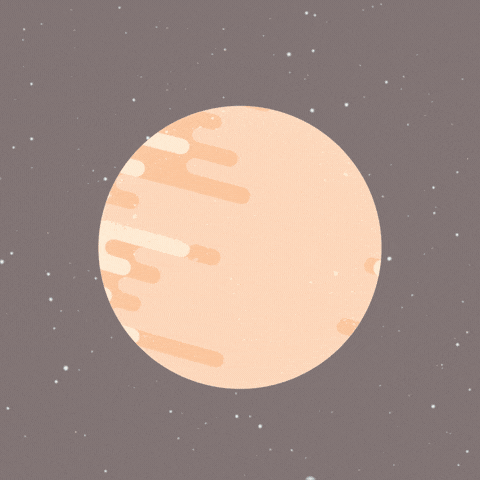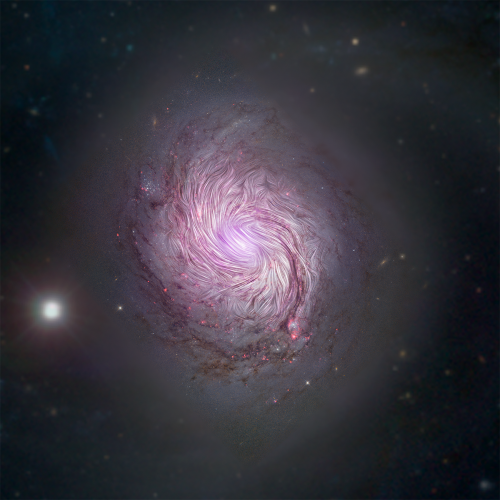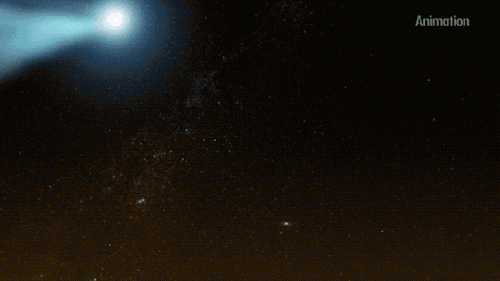Cool Space GIFs From The Internet
Cool Space GIFs from the Internet
There’s a lot of historical and archived space footage on the internet and we’re excited to see that the public (you!) have taken it to create many other products that teach people about exploration, space and our universe. Among those products are GIFs. Those quick videos that help you express what you’re trying to say via text, or make you laugh while surfing the web.
Are space GIFs the new cat videos of the internet? Don’t know, but we sure do like them!
Here are a few neat space GIFs from the internet…
This GIF of the Cat Eye Nebula shows it in various wavelengths…

Followed by a GIF of a cat in space…floating in front of the Antennae galaxies...

One time, a frog actually photobombed the launch of our LADEE spacecraft…someone on the internet gave him a parachute…

Want to see what it’s like to play soccer in space? There’s a GIF for that…

There are also some beautiful GIFs looking through the Cupola window on the International Space Station…


This warped footage from the International Space Station gives us ride around the Earth…

While this one encourages us to explore the unknown...

When our New Horizons spacecraft flew by dwarf planet Pluto in 2015, the internet couldn’t get enough of the Pluto GIFs...


NASA GIFs

Want to dive into a black hole of other fun space GIFs? Check out our GIPHY page HERE.
Want to use our GIFs?! You can! Our GIFs are accessible directly from the Twitter app. Just tap or click the GIF button in the Twitter tool bar, search for NASAGIF, and all NASA GIFs will appear for sharing and tweeting. Enjoy!
GIF Sources
Cat Eye GIF: https://giphy.com/gifs/astronomy-cZpDWjSlKjWPm Cat GIF: https://giphy.com/gifs/cat-HopYL0SamcCli Frog GIF: https://giphy.com/gifs/nasa-photo-rocket-NOsCSDT2rUgfK Soccer GIF: https://giphy.com/gifs/yahoo-astronauts-zerogravity-QF1ZomA11zofC Cupola 1 GIF: https://giphy.com/gifs/nasa-Mcoxp6TgvQm6A Cupola 2 GIF: https://giphy.com/gifs/timelapse-space-11f3o8D2rQWzCM Earth GIF: http://giphy.com/gifs/earth-milky-way-international-space-station-ONC6WgECm5KEw Explore GIF: https://giphy.com/gifs/text-timelapse-lapse-Vj7gwAvhgsDYs Pluto 1 GIF: https://giphy.com/gifs/l46CzjUnYFfeMXiNO Pluto 2 GIF: https://giphy.com/gifs/pluto-dbV1LkFWWob84
Make sure to follow us on Tumblr for your regular dose of space: http://nasa.tumblr.com
More Posts from Nasa and Others
@mothdog: What is something everyone needs to know about the International Space Station and science in space?

Completely invisible, yet unbelievably influential. 💫
According to new research from our Stratospheric Observatory for Infrared Astronomy (SOFIA), spiral galaxies like the Milky Way are shaped by magnetic fields. These magnetic fields are invisible to the human eye.
However, by combining imagery from our Hubble Space Telescope, the Nuclear Spectroscopic Array and the Sloan Digital Sky Survey, the magnetic fields become apparent. In this image, scientists measured the magnetic fields along the spiral arms of the galaxy called NGC 1068. The fields are shown as streamlines that closely follow the circling arms.
Image Credit: NASA/SOFIA; NASA/JPL-Caltech/Roma Tre Univ.
Make sure to follow us on Tumblr for your regular dose of space: http://nasa.tumblr.com.
How Airglow Can Help Us Understand the Sun’s Influence on Earth
You may have seen the famous blue marble or pale blue dot images showing Earth from 18,000 and 3.7 billion miles away, respectively. But closer to home — some 300 miles above Earth's surface — you might encounter an unfamiliar sight: vibrant swaths of red and green or purple and yellow light emanating from the upper atmosphere.
This light is airglow.

Airglow is created when atoms and molecules in the upper atmosphere, excited by sunlight, emit light to shed excess energy. Or, it can happen when atoms and molecules that have been ionized by sunlight collide with and capture a free electron. In both cases, these atmospheric particles emit light in order to relax again. The process is similar to how auroras are created, but while auroras are driven by high-energy solar wind, airglow is energized by day-to-day solar radiation.

Since sunlight is constant, airglow constantly shines throughout Earth’s atmosphere, and the result is a tenuous bubble of light that closely encases our planet. Its light is too dim to see easily except in orbit or on the ground with clear, dark skies and a sensitive camera — it’s one-tenth as bright as the light given off by all the stars in the night sky.

Airglow highlights a key part of our atmosphere: the ionosphere. Stretching from roughly 50 to 400 miles above Earth’s surface, the ionosphere is an electrified layer of the upper atmosphere generated by extreme ultraviolet radiation from the Sun. It reacts to both terrestrial weather below and solar energy streaming in from above, forming a complex space weather system. Turbulence in this ever-changing sea of charged particles can manifest as disruptions that interfere with Earth-orbiting satellites or communication and navigation signals.

Understanding the ionosphere’s extreme variability is tricky because it requires untangling interactions between the different factors at play — interactions of which we don’t have a clear picture. That’s where airglow comes in. Each atmospheric gas has its own favored airglow color, hangs out at a different height and creates airglow by a different process, so we can use airglow to study different layers of the atmosphere.

Airglow carries information on the upper atmosphere’s temperature, density, and composition, but it also helps us trace how particles move through the region itself. Vast, high-altitude winds sweep through the ionosphere, pushing its contents around the globe — and airglow’s subtle dance follows their lead, highlighting global patterns.

Two NASA missions take advantage of precisely this effect to study the upper atmosphere: ICON — short for Ionospheric Connection Explorer — and GOLD — Global-scale Observations of the Limb and Disk.
ICON focuses on how charged and neutral gases in the upper atmosphere behave and interact, while GOLD observes what drives change — the Sun, Earth’s magnetic field or the lower atmosphere — in the region.

By imaging airglow, the two missions will enable scientists to tease out how space and Earth’s weather intersect, dictating the region’s complex behavior.
Keep up with the latest in NASA's airglow and upper atmosphere research on Twitter and Facebook or at nasa.gov/sunearth.
Make sure to follow us on Tumblr for your regular dose of space: http://nasa.tumblr.com.
Solar System: Things to Know This Week
Not to be—ahem—eclipsed, the Perseids meteor shower peaks annually in mid-August and is considered the most popular meteor shower of the year.
This week, 10 things you need to know about this beautiful nighttime show and how to catch a front-row seat.
1. Light in August

In this 30 second exposure, a meteor streaks across the sky during the annual Perseid meteor shower Friday, Aug. 12, 2016 in Spruce Knob, West Virginia. The Perseids show up every year in August when Earth ventures through trails of debris left behind by an ancient comet. Image Credit: NASA/Bill Ingalls
With very fast and bright meteors, Perseids (pronounced PURR-see-ids) frequently leave long "wakes" of light and color behind them as they streak through Earth's atmosphere. Perseids are one of the most plentiful showers, with between 50-100 meteors seen each hour, and occur with warm summer nighttime weather, allowing sky watchers to easily view them.
2. Show Schedule
You can see the Perseids this year between now and Aug. 24, 2017, but mark your calendars for peak dates Aug. 12 and 13. This year, the waning gibbous moon rises about midnight local time, which will cut the expected rates in half this year (25 to 50 per hour at the peak from a very dark sky). But the Perseids are so bright and numerous that it should still be a good show.
3. Night Owls Welcome
The Perseids (and every meteor shower) are best viewed in the Northern Hemisphere between 11 p.m. - 3 a.m. Come prepared with a sleeping bag, blanket or lawn chair.
4. Look Up

Find an area well away from city or street lights and set up where you're shadowed from the moon's glare. Face whatever direction you like, ideally the one unobstructed by trees, buildings or moonlight. Look up, taking in as much of the sky as possible. If you have a group, each person should look in different parts of the sky. After about 30 minutes in the dark, your eyes will adapt, and you'll begin to see fainter objects, including meteors. Be patient; the show will last until dawn, so you have plenty of time to catch a glimpse.
5. Functional Fashion
Pack a baseball cap and wear it sideways to cover any glare from the moon. The waning gibbous moon will block out many of the fainter meteors this year, but the Perseids are so bright and numerous that it should still be a good show.
6. Meteor Matters
Where do meteors come from? Some originate from leftover comet particles and bits of broken asteroids. When comets come around the sun, they leave a dusty trail behind them. Every year, Earth passes through these debris trails, which allows the bits to collide with our atmosphere and disintegrate to create fiery and colorful streaks in the sky. But the vast majority of meteors don't come from meteor showers—instead, they randomly fall all of the time.
7. Origins

The pieces of space debris that interact with our atmosphere to create the Perseids originate from Comet 109P/Swift-Tuttle. Swift-Tuttle takes 133 years to orbit the sun once, and Comet Swift-Tuttle last visited the inner solar system in 1992. Swift-Tuttle is a large comet: its nucleus is 16 miles (26 kilometers) across. This is almost twice the size of the object hypothesized to have wiped out the dinosaurs.
8. Discoverers
Comet Swift-Tuttle was discovered in 1862 by Lewis Swift and Horace Tuttle. In 1865, Giovanni Schiaparelli realized that this comet was the source of the Perseids.
9. Great Balls of Fire

The Perseids are known for fireballs, which are large explosions of light and color that last longer than an average meteor streak. Why? They originate from bigger particles of cometary material.
10. Sky Map
The point in the sky from which the Perseids appear to come from—also known as their radiant—is the constellation Perseus. But don't get confused: The constellation name only helps viewers figure out which shower they're viewing on a given night; it's not the source of the meteors (see #6 for that answer!).
Make sure to follow us on Tumblr for your regular dose of space: http://nasa.tumblr.com
Hello Dr Kate Rubins, why conduct your researches in space? What is there in space that you need for your research? Best regards.
5 Myths About Becoming an Astronaut
Editor’s Note: This post was updated on March 15, 2024, to reflect new URLs and updated qualifications for applicants.
Have you ever wondered if you have what it takes to become a NASA astronaut? The term “astronaut” derives from the Greek word meaning “star sailor.”
We’re looking for a new class of astronauts to join the NASA team, and if you’re thinking about applying, there are a few things you should know.
Here are a few myths about becoming an astronaut:
MYTH: All astronauts have piloting experience.
FACT: You don’t need to be a pilot to be an astronaut. Flying experience is not a requirement, but it could be beneficial to have.

MYTH: All astronauts have perfect vision.
FACT: It’s OK if you don’t have 20/20 vision. As of September 2007, corrective surgical procedures of the eye (PRK and LASIK), are now allowed, providing at least one year has passed since the date of the procedure with no permanent adverse aftereffects.

MYTH: All astronauts have advanced degrees, like a PhD.
FACT: While a master’s degree from an accredited university is typically necessary to become an astronaut, an exception exists if you have completed a medical degree or test pilot school.

MYTH: Astronauts are required to have military experience to be selected.
FACT: Military experience is not required to become an astronaut.

MYTH: You must be a certain age to be an astronaut.
FACT: There are no age restrictions. Astronaut candidates selected in the past have ranged between the ages of 26 and 46, with the average age being 34.

OK, but what are the requirements?

Basic Qualification Requirements
Applicants must meet the following minimum requirements before submitting an application:
Be a U.S. citizen.
Have completed a master’s degree (or foreign equivalent) in an accredited college or university with major study in an appropriate technical field of engineering, biological science, physical science, computer science, or mathematics.
The master’s degree requirement can also be met by having:
Completed at least two years (36 semester hours or 54 quarter hours) in an accredited PhD or related doctoral degree program (or foreign equivalent) with major study in an appropriate technical field of engineering, biological science, physical science, computer science, or mathematics.
Completed a Doctor of Medicine, Doctor of Osteopathic Medicine, or related medical degree (or foreign equivalent) in an accredited college or university.
Completed or be currently enrolled in a Test Pilot School (TPS) program (nationally or internationally recognized) and will have completed this program by June 2025. (Must submit proof of completion or enrollment.)
If TPS is your only advanced technical degree, you must have also completed a bachelor’s degree or higher (or foreign equivalent) at an accredited college or university with major study in an appropriate technical field of engineering, biological science, physical science, computer science, or mathematics.
Have at least three years of related professional experience obtained after degree completion (or 1,000 Pilot-in-Command hours with at least 850 of those hours in high-performance jet aircraft for pilots). For medical doctors, time in residency can count toward experience and must be completed by June 2025.
Be able to pass the NASA long-duration flight astronaut physical.
Applications for our next astronaut class are open through April 2! Learn more about our Astronaut Selection Program and check out current NASA astronaut Anne McClain’s advice in “An Astronaut’s Guide to Applying to Be an Astronaut.”
Make sure to follow us on Tumblr for your regular dose of space!
Keep reading
do you have a favourite planet etc?
can you describe how earth looks like from space?
@flood123789: What does it feel like to drink a lot of water in zero gravity
Cosmic Piece of Pi!
Did you know that pi is involved nearly anywhere you look? We’re not talking about your favorite pastry! Pi (also written as the Greek letter 𝞹, or the number 3.14159...) is an irrational number, which means it can’t be written as a simple fraction like ½. It is the ratio of a circle’s circumference (the distance around its edge) to its diameter (the distance across it) and will always be the same number, regardless of the circle’s size. Here are some places you can find pi in the universe around us!

Our Transiting Exoplanet Survey Satellite, TESS, watches slices of the sky in its hunt for worlds outside our solar system — how many exoplanets are in its night-sky pie? Last July, TESS scientists created a mosaic of 208 images of the southern sky. At that time, it contained 29 confirmed and 1,000 possible exoplanets, and we’re still studying the data to find more. Since this awe-inspiring image is of the southern hemisphere (or half of a 3D circle), there will always be pi! Every slice contains something delicious for scientists to study.

Pi recently played a crucial role in new discoveries about Alpha Draconis, a well-studied pair of stars. After discovering these stars regularly eclipse each other, pi helped scientists learn more about them. Scientists detected the eclipses while monitoring the brightness of Alpha Draconis for periodic dips that could’ve been caused by planets passing between the star and us. Instead of a planet, though, researchers found that its smaller partner in crime was passing in between us and the larger star for about six hours at a time! 💫

Pi comes in handy as we learn more about these two stars. Knowing the percentage of the decrease in Alpha Draconis’ light and the formula for the area of a circle (A=𝞹r2 — or area equals pi times the square of the circle's radius), scientists can predict the sizes of both stars. Because stars typically orbit in an elliptical (or oval) shape, pi also helps scientists use the detection of these eclipses to figure out the orbits of the two stars!

So far we’ve seen pi in many places! But it's also interesting to look at where pi can't be found! We mentioned earlier that many orbit calculations involve pi … but not every one does! Pi does not factor into calculations of hyperbolic orbits — orbits that aren't complete, or don't return to where they started — the same way that it does with elliptical orbits! This is most commonly seen with comets. While many comets orbit normally in our solar system, some oddballs just pass through, like the interstellar ‘Oumuamua that zipped passed us in 2017. ☄️

Perhaps the most popular place you may find pi is in the shape of a typical pie! While NASA’s Fermi Gamma-ray Space Telescope studies gamma-rays, and not blueberries, we think this cool Fermi pie is worth sharing for Pi Day!
Find more ways scientists look up at the night sky and use pi here. And now, don’t be irrational, and go have some pi(e)! 🥧
Make sure to follow us on Tumblr for your regular dose of space: http://nasa.tumblr.com
-
 dofitabathsrous liked this · 1 year ago
dofitabathsrous liked this · 1 year ago -
 kewpiiie reblogged this · 5 years ago
kewpiiie reblogged this · 5 years ago -
 kewpiiie liked this · 5 years ago
kewpiiie liked this · 5 years ago -
 thealmightykurama reblogged this · 7 years ago
thealmightykurama reblogged this · 7 years ago -
 a-n-i-m-e-us reblogged this · 7 years ago
a-n-i-m-e-us reblogged this · 7 years ago -
 chikasmania liked this · 7 years ago
chikasmania liked this · 7 years ago -
 zoyt0y reblogged this · 7 years ago
zoyt0y reblogged this · 7 years ago -
 zoyt0y liked this · 7 years ago
zoyt0y liked this · 7 years ago -
 computer-deactivate-iguana reblogged this · 8 years ago
computer-deactivate-iguana reblogged this · 8 years ago -
 terri104 reblogged this · 8 years ago
terri104 reblogged this · 8 years ago -
 terri104 liked this · 8 years ago
terri104 liked this · 8 years ago -
 nochoramet reblogged this · 8 years ago
nochoramet reblogged this · 8 years ago -
 threadsofstarlight liked this · 8 years ago
threadsofstarlight liked this · 8 years ago -
 mortie-sch liked this · 8 years ago
mortie-sch liked this · 8 years ago -
 intheenditdoesnotevenmatter liked this · 8 years ago
intheenditdoesnotevenmatter liked this · 8 years ago -
 dreamers-dream liked this · 8 years ago
dreamers-dream liked this · 8 years ago -
 jillandjackalope liked this · 8 years ago
jillandjackalope liked this · 8 years ago -
 mrvmt liked this · 8 years ago
mrvmt liked this · 8 years ago -
 xephii reblogged this · 8 years ago
xephii reblogged this · 8 years ago -
 spinatlasagne-blog reblogged this · 8 years ago
spinatlasagne-blog reblogged this · 8 years ago -
 maybe-me-001 reblogged this · 8 years ago
maybe-me-001 reblogged this · 8 years ago -
 dngrs reblogged this · 8 years ago
dngrs reblogged this · 8 years ago -
 dngrs liked this · 8 years ago
dngrs liked this · 8 years ago -
 eisteekind liked this · 8 years ago
eisteekind liked this · 8 years ago -
 fangirlingtendencies reblogged this · 8 years ago
fangirlingtendencies reblogged this · 8 years ago -
 sinaisinais reblogged this · 8 years ago
sinaisinais reblogged this · 8 years ago -
 umabeca liked this · 8 years ago
umabeca liked this · 8 years ago -
 xixichelth liked this · 8 years ago
xixichelth liked this · 8 years ago -
 wrantingwriter-blog liked this · 8 years ago
wrantingwriter-blog liked this · 8 years ago -
 carnegiestout reblogged this · 8 years ago
carnegiestout reblogged this · 8 years ago -
 augusteightnine reblogged this · 8 years ago
augusteightnine reblogged this · 8 years ago -
 jeza-jezaro reblogged this · 8 years ago
jeza-jezaro reblogged this · 8 years ago -
 fleurdebach5-blog liked this · 8 years ago
fleurdebach5-blog liked this · 8 years ago -
 stvidomina liked this · 8 years ago
stvidomina liked this · 8 years ago -
 euronym0us reblogged this · 8 years ago
euronym0us reblogged this · 8 years ago -
 dani1598-blog liked this · 8 years ago
dani1598-blog liked this · 8 years ago
Explore the universe and discover our home planet with the official NASA Tumblr account
1K posts